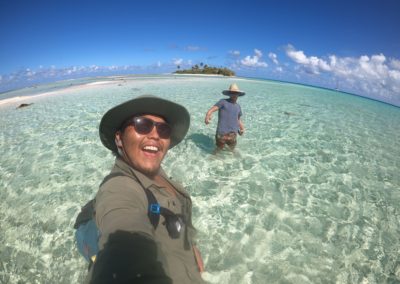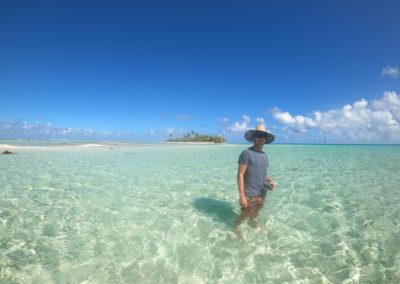
From the first moment on Makemo was stunning!
Fine silhouettes of coconut palms on the horizon were the first signs of our imminent arrival in paradise. Gradually the contours became sharper and the individual fragments merged into a continuous fringe of palms and sand – The eastern edge of the Makemo Atoll.

It was exciting! We reached the pass a few minutes before the announced slacktide and observed the pass with our binoculars. While we waited heaved to, we could see the water in the pass getting calmer and calmer, the current dying down, and gradually more and more small fishing boats coming out to fish.
The time had come! Slacktide! We opened the baked genoa and pulled the sail over to the other side. The wind had died and so we quickly shook the last reef out of the mainsail before picking up speed and making our way into the atoll.
Emma was responsible for the sails and G kept a good watch out at the front of the bow. He had to make sure that the course I steered was clear from dangers: deep blue or turquoise water was good; a brown color, on the other hand, meant: „Watch out, reef ahead!
In the end, we knew that all the information on the chart was correct. – The channel was buoyed and the depths matched our observations. We got the sails tight to pass the last bit hard to wind. Then we dropped to starboard, eased the sails and took a shortcut across five meters of deep water to glide downwind to our anchorage off the small village of Pouheva.

On our first visit ashore, we were a bit disappointed. The streets were deserted. We had completely forgotten that it was Whit Monday. Public holiday. – Locals were swinging in hammocks or listening to music in their homes. Supermarkets were closed and fishermen stayed home.
The next day, a completely different sight: The streets were bustling with activity; even a small handicraft store was open. The kids played in the gardens and we chatted with the locals. At a fisherman we exchanged a pair of bananas and grapefruits for three decent fish.
While they gutted and scaled the fish for us, I took the opportunity to find out which fish were edible and which I should rather keep my hands off when spearfishing.

The problem here is ciguatera, a toxin from a protozoan that attaches itself to algae, primarily found in tropical areas. The toxin accumulates in fish flesh and is passed up the food chain to large predators. Harmless to fish, it affects the nervous system in humans, can cause stake poisoning symptoms, and in the worst case can kill a human. Which fish exactly are affected varies from atoll to atoll. Sometimes a fish that is edible here is no longer safe to eat one bay away!
With our fresh fish on board, we prepared to weigh anchor. About two nautical miles to the south lay two tiny uninhabited motus to which we were eager to sail to enjoy a few days on beach vacation.
On the way, one of us always had to keep a lookout at the bow: The interior of the atoll is peppered with coral heads („bummies“) that reach vertically to just below the water surface like fists. With the sun in our necks and polarizing goggles, however, we were usually able to spot them from a great distance and could avoid them altogether.
Eight boats were anchored nearby, but everyone went about their own business and so we had the small motus to ourselves! We spent the first day on the right island and the second day we were relaxing on the left. It was pure paradise!
After coffee and breakfast, we packed water, some snacks, snorkel gear, the speergun and went ashore. On foot we explored the small island, walked to the outer reef edge and back. The beach, a few palm trees and shrubs. – That’s it!

Underwater there was a kind of forest of coral heads; white sand between them. It was nice to see so many different colorful fish, corals and shells. In a little deeper water, after some time, I caught a grouper, a parrotfish, and a nosefish, which I prepared for barbeque on the beach.
In the afternoon we went back to the boat for a short while. We exchanged snorkeling gear for plates and bbq equipment and made our way back to our island as quickly as possible. Emma started a fire and shortly after the fish sizzled together with some vegetables in the pan we had brought with us.



Back at the village we filled up our supplies. Emma and G snorkeled on the shore and I did some dining on board when I suddenly saw SY EMMA entering the atoll! We were all very happy about the not so early expected reunion and arranged to have boatdrinks and dinner together.
We told them about our plans to sail further to the north of the atoll, to look for a quiet anchorage and to continue through the northern pass to Fakarava a few days later. As the crew of EMMA had a few more days before they expected new sailors and so they joined us the next morning to sail on with us.
After a restless night with high waves and a lot of rocking at the anchorage, we left early in the morning:
This journey is my dream! If you want to support me and keep the journey going, please feel free to invite me for a symbolic dinner!
Thank you so much!
Again, we had the problem with the coral heads. – And not all of them were listed in the sea chart. Also, this time the weather was not so friendly. From behind we were chased by a proper squall and from the front the sun was blinding.
We managed to avoid the rain with an evasive maneuver to the west, but after we had scraped past an unmarked reef by a hair’s breadth, my tension became too great. – I climbed the mast and sat on the lower spreader to have a better view „through“ the water surface. There I stayed for the remaining two hours until we safely reached our anchorage two hours later.

With Kurt, Adian and Susi, the crew of Emma we had dinner together. G and Emma prepared sushi from our self-caught fish. Kurt made a delicious BBQ sauce from Eugin’s recipe and I grilled the marinated goat (which we had hunted together in Hiva Oa) on the boatbarbeque.
I love it! – The food tastes twice as good when you know firsthand where the food comes from, and you have prepared almost everything yourself!
We stayed at our anchorage for another day. Susi, G and I went diving at the reef. Not deep; 10 meters maximum, but it was nice to dive again. There is a lot of time to look at the underwater world, to watch fish and to push your head as close as possible to the corals to observe the many little animals hiding in them.
On board of EMMA there is a compressor, with which we could refill the bottles after the dive. We used the dive also as an equipment check, without accusing us of having wasted the „precious breathing air“ for a relatively unspectacular dive.
In the evening we made a fire on the beach and drank fresh coconuts with a shot of rum. – Not too much, because the next day the three of us went on to the next atoll: to Fakarava, 85 nautical miles away.















